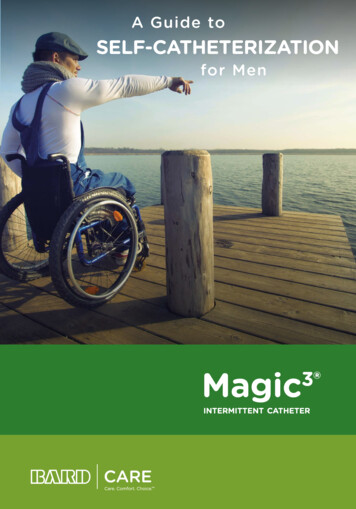
Transcription
A Guide toSELF-CATHETERIZATIONfor Men
Intermittent self-catheterization (ISC) is a simple procedure thatdrains urine from the bladder. It can be carried out safely at home,at work, or when traveling. ISC should not restrict your busy life. Theprimary purpose of this booklet is to provide instructions for useconcerning the Magic3 Catheter. Other recommendations are forinformational use only and may not apply to your condition. Alwaysconsult with your healthcare professional.Take Back Control of YourBLADDERCLINICIAN:CLINIC OR HOSPITAL:TELEPHONE NUMBER:CATHETER:EMERGENCY NUMBER:FR SIZE:GENERAL INFORMATION:1REF NUMBER:
MANAGEMENT2
USEFUL INFORMATIONThe bloodstream carries the body’s waste products to the kidneyswhere they are filtered from the blood and combined with water toproduce urine. The urine flows – via tubes called ureters – from thekidneys to the bladder.The bladder acts as a storage vessel for urine. As it gradually fillswith urine, the stretch receptors in the bladder wall send messagesto the brain that it is time to think about emptying. When functioningnormally, the bladder receives signals from the brain that cause theurethral sphincter to open and the bladder walls to contract. Theurine is then discharged from the bladder through the urethra. Aman’s urethra is about 8 inches long and runs from his bladder tooutside the body at the tip of his penis.REASONS THAT MAYCONTRIBUTE TOURINARY INCONTINENCE:KIDNEYS Nerve damage, such as spinal cordinjury or diseases that affect thenervous systemURETERS Poor bladder tone Back injury Pelvic surgeryBLADDER The presence of urethralobstructionsURETHRA Problems with the normalfeedback mechanism betweenbladder and brain Constipation3
ABOUT YOUR ANATOMYUrination typicallyoccurs 4-6 times per day,or whenever the bladdercollects 200-400mlof urine. Production ofurine slows down duringthe night, decreasing theneed for urination.BladderRectumUrethraPenisNormally the bladder will be virtually empty when you finishurinating, but in some people the process of urination remainsincomplete, leaving a residual pool of urine in the bladder. Residualurine provides a haven for bacterial growth and may lead to a urinarytract infection.HELPFUL HINTS FOR BLADDER MANAGEMENT Always follow the advice of your healthcare professional. The followinghints may not apply to you. Always maintain a good healthy diet and keep your fluid intake upat a level of about 6-8 cups each day. Contact your clinician for advice if you become constipated as this canaffect your bladder function. If your urine becomes cloudy or has an unpleasant odor, or you havea burning sensation or discomfort while passing urine, increase yourfluid intake and contact your clinician as these symptoms may indicatea urinary tract infection. Should you run an elevated temperature, contact your clinicianimmediately.4
INTERMITTENT SELF-CATHETERIZATION (ISC)If the bladder cannot be emptied completely through normalurination, it can be drained by inserting a thin tube up the urethra andinto the bladder. The tube, called a catheter, is removed whendrainage is complete.This procedure is called ISC andmost men can easily learn to do itthemselves. Upon prescription byyour doctor, ISC is taught by speciallytrained healthcare professionals whoprovide training and advice to ensurecorrect procedures are followedto minimize risks.TIPS FOR INTERMITTENTSELF-CATHETERIZATION To help minimize the risk of contamination of thecatheter, avoid touching the tip with your fingers andavoid letting the catheter touch other surfaces. Try to stay relaxed when inserting the catheter. If youfeel tense, your sphincter muscle may tighten andmake it difficult to insert or withdraw the catheter.Coughing can help relax your sphincter muscle. Remember that your catheter is designed to be usedone time only. After each use, the catheter should bediscarded in a suitable receptacle.5
ABOUT YOUR MAGIC 3 INTERMITTENT CATHETERYour Magic3 intermittent catheter with m3 technology has many specialfeatures that help make it soft and comfortable to use, but easyto handle.Ultra-soft outer layerdesigned to help maximizecomfort Designed from a uniquecomposite of three distinctall-silicone layers. The tapered seamless catheter tip isdesigned to pass smoothly throughyour urethra and into your bladder.Firm middle layerfor easy handlingPliable innermostlayer for easyinsertion Four comfort-sized drainage eyes in thecatheter tip allow urine to flow through thecatheter tube and into the toilet or a collection device. The funnel shaped catheter outlet end may also be connectedto a urine collection bag, if preferred. The all-silicone design eliminates allergies, toxins or disposal concerns thatmay be associated with latex and PVC catheters. Available with a hydrophilic coating that becomes slippery when wet, forvirtually friction-free insertion and removal. Available with an antibacterial coating that has demonstrated to producelocalized antibacterial activity in pre-clinical testing.* Available with Sure-Grip , allowing the catheter to be held firmly withouttouching the surface, to help minimize the risk of contamination, and givingthe user more control while catheterizing.*Pre-clinical testing may not correlate with outcomes in humans6
HOW TO PREPARE AND USE YOURAlways try to pass urine and empty your bladder asStep 1Wash your hands thoroughly with soap and waterand dry them. Washing your hands properly will helpensure that you don’t accidentally contaminatethe catheter. You should pay particular attention towashing between your fingers and the backs of yourhands - these are areas that are often overlooked.Step 2StandardCarefully open the catheter package to expose the entire length ofthe catheter. Lubricate the tip and shaft of the catheter with watersoluble lubricant being careful not to place the catheter on an uncleansurface.HydrophilicPrior to opening the package, release the sterilewater from the foil packet by squeezing itfirmly between your fingers and thumb.Tip the catheter pouch end-to-end three tosix times to thoroughly wet the catheter surface.Peel open the package at the funnel end justenough to allow you to grip the catheterfunnel. Don’t remove the catheter just yet.Use the adhesive tab at the funnel end ofthe package to stick it to a nearby dry, vertical surface3-6Xwhile preparing to catheterize.7
MAGIC 3 INTERMITTENT CATHETERmuch as you can before using an intermittent catheter.Step 3Always wash the tip of your penis beforecatheterizing, using a new wet wipe if you like.You can catheterize in a number of differentpositions, as shown in the illustrations. You can sitor stand by the toilet. Your clinician will help youfind the position that suits you.If you are in a wheelchair, your clinician will advise youon how ISC can be adapted for your particular needs. Never strain to empty your bladder. Only try topass urine prior to passing the catheter if agreedwith your clinician. It is possible to catheterize without removing amale external catheter. This helps to preserve skinintegrity, but you may not be able to adequatelyclean your penis prior to catheterization andshould discuss the procedure with your clinician. You may find it easier to drain your bladder into a container, ratherthan directly into the toilet. If preferred, a urine collection bag can beattached to the catheter funnel before insertion.8
HOW TO PREPARE AND USE YOURAlways try to pass urine and empty your bladder asStep 4With Sure-Grip SleeveWash your hands again. Hold the insertionsleeve with your dominant hand and squeezeit to grip the catheter shaft as you remove thecatheter from the package. Next, hold thecatheter funnel above the insertion sleeve withyour other hand and slide the insertion sleevedown the shaft, stopping at about 6” from thetip. Release the funnel. Using the insertion sleeve to hold the catheterfirmly, gently pass the tip of the catheter into your urethra until theinsertion sleeve nears the meatus.Repeat until urine starts to flow.Without Sure-Grip SleeveWash your hands again and take the catheterout of the package holding the funnel end.Pass the tip of the catheter into the opening ofyour urethra and continue until urine starts to flow.Helpful Tips If you have foreskin, gently pull it back and keep it in position untilcatheterization is completed. Hold your penis up towards your stomach as this will make it easierto slide the catheter into your bladder. Avoid squeezing the penis as this can block your urethra. If you feel that the catheter is not moving freely enough towardsyour bladder, it may be helpful to cough or try to pass urine, as thiscan make insertion easier.9
MAGIC 3 INTERMITTENT CATHETERmuch as you can before using an intermittent catheter.Step 5As soon as urine starts to flow, point your penis downwards towards the toilet orother collection device. Try to keep the catheter steady until urine stops flowing.When urine stops flowing, slowly withdraw the catheter, stopping if flow startsonce more, until the last few drops have drained.Step 6Finish by disposing of the catheter and itspackaging in a waste receptacle – do notflush it down the toilet. Wash your hands withsoap and water, just as you would normallydo.10
FREQUENTLY ASHow often should I catheterize? This will depend on the amount ofyour fluid intake, the amount of residual urine to be drained and theeffect of any medication you may be taking. Some people may onlyneed to catheterize once daily, while others may catheterize up to sixtimes a day. Your clinician will advise on a schedule that will suit you.How much fluid should I drink? Depending on your doctor’s adviceand your health, you should drink about 6-8 cups of fluid every day.What do I do if I can’t insert the catheter? Just relax for a few minutesand try again. You may be anxious causing your sphincter muscle totighten. Coughing may help. If you still have difficulty, contact yourclinician for further advice.What if there is blood in my urine? Sometimes there may be specks ofblood on the catheter or slight bleeding after removal. Don’t worry, asthis will usually clear up in a couple of days. If the bleeding persists, youshould contact your clinician for advice or go to the emergency roomat your local hospital.What if the catheter won’t come out? This can happen if you aretense. When you are tense your muscles can go into spasm and preventthe catheter from coming out. Eventually these muscles will relax andallow you to remove the catheter, so rest for a few moments then tryagain. Coughing several times as you begin to remove the catheterwill also help. If these suggestions don’t work, you should contact yourclinician or go to the emergency room at your local hospital for help.Can I travel overseas? Ask your clinician for a letter stating that youare carrying the catheters to manage a medical problem.Which type of catheter should I choose? There are many differenttypes of catheters and your clinician will show you a selection fromthose that are suitable for you. Together you will be able to choose onethat suits you best.11
SKED QUESTIONSDoes Intermittent Self Catheterization (ISC) hurt? It may feel like astrange sensation at first, but ISC should not be painful. For some theurethra is more sensitive when first learning, but ask your doctor foradvice if this does not settle with time.From now on, will I always have to catheterize? This will dependon the underlying reasons for catheterization. Sometimes ISC is atemporary measure until your bladder and urinary sphincter regainnormal function. You should report any changes in drainage volumeor pattern of passing urine to your clinician who will review theclinical need for continuing ISC, or altering the frequency.What should I do if I forget to catheterize? You should catheterizeas soon as you remember. Then continue as normal at the regularintervals you have been advised. Remember that you mustcompletely empty your bladder to remove any residual urine andreduce the risk of infection.What happens if I do not catheterize as often as I was told to? Ifyou miss catheterizations once or twice don’t worry, but if thishappens often it can cause various adverse events such as a urinarytract infection or urinary leakage. If the pressure in your bladderbecomes too high there is a risk that your urine may back up to yourkidneys, which can cause serious injury.Note: The frequently asked questions are provided as general healthguidelines and may not be applicable to your particular healthcondition. Your individual health status and any required medicaltreatments can only be properly addressed by a professionalhealthcare provider of your choice. Remember: Always consult withyour healthcare professional.12
OUTPUT CHARTEach day record the time and amount of urine youWEEK 1TimeP/CMondayTuesday Wednesday ThursdayFridaySaturdaySundayMondayTuesday Wednesday ThursdayFridaySaturdaySundayPCPCPCPCPCPCWEEK 2TimeP/CPCPCPCPCPCPCP Urine was passed normallyC Urine was passed via catheter13
(4 WEEKS)voided normally or via a catheter (measured in ml/cc).WEEK 3TimeP/CMondayTuesday Wednesday ThursdayFridaySaturdaySundayMondayTuesday Wednesday ThursdayFridaySaturdaySundayPCPCPCPCPCPCWEEK 4TimeP/CPCPCPCPCPCPCP Urine was passed normallyC Urine was passed via catheter14
HOW TO OBTAIN SUPPLIESYour clinician will provide you with a prescription for intermittentcatheters. Ask your clinician to write down the descriptionand codes of the catheter selected for you in the front of thisbooklet. The order numbers shown here will helpto identify the correct product.CATHETERREF NUMBERFR SIZEMagic3 533XXMagic3 Antibacterial539XX10 FRMagic Hydrophilic536XX12 FRMagic Hydrophilic w/SureGrip Sleeve536XXG14 FRMagic Hydrophilic w/SureGrip Sleeve w/Coudé Tip506XX16 FRMagic3 Antibacterial Hydrophilic535XXMagic3 Antibacterial Hydrophilic w/SureGrip Sleeve535XXG3331518 FR20 FR
Supplies can be obtained from a medical supply company. Theyoffer a discreet and convenient way to obtain supplies quicklyand easily. Additionally, they will process your insurance claimsfor you at no additional cost. Ask your clinician to recommenda medical supply company or call us at 800.243.3315 forassistance.16
ADDITIONAL RESOURCESBard MedicalDivision800.243.3315American UrologicalAssociation Foundation410.689.3700American Spinal InjuryAssociation (ASIA)404.355.9772Christopher & DanaReeve Foundation800.539.7309National Associationfor Continence (NAFC)800.BLADDER843.377.0900National MultipleSclerosis Society800.344.4867National Spinal Cord InjuryAssociation (NSCIA)800.962.9629Paralyzed Veterans ofAmerica (PVA)800.555.9140The Simon Foundationfor Continence800.23Simon (800.237.4666)For further information or assistance contact your healthcareprofessional.17
NOTES18
Bard Medical Division is the world’s leading developer andmanufacturer of silicone catheters for urological continencecare and bladder drainage. We have dedicated ourselves toimproving lives through advanced technology, excellent productperformance, and greater product options.Summary of Indications & Warnings: Intermittent catheters are intended foruse by adult and pediatric, male and female patients for draining urine fromthe bladder. Reuse of a single use device may create a risk of patient or userinfection; compromise the device which may lead to device failure and/orinjury, illness or death of the patient. Please consult product labels and insertsfor more detailed safety information and instructions for use.C. R. Bard, Inc.8195 Industrial Blvd., Covington, GA800-243-3315www.bardcare.comBard, Magic3 and Sure-Grip are trademarks and/or registered trademarks of C. R. Bard, Inc. 2014 C. R. Bard, Inc. All Rights Reserved. 1502-29 05/15 THP P06/15 5M
A Guide to for Men SELF-CATHETERIZATION. 1 Take Back Control of Your BLADDER MANAGEMENT Intermittent self-catheterization (ISC) is a simple procedure that drains urine from the bladder. It can be carried out safely at home, at work, or wh










